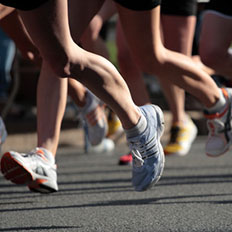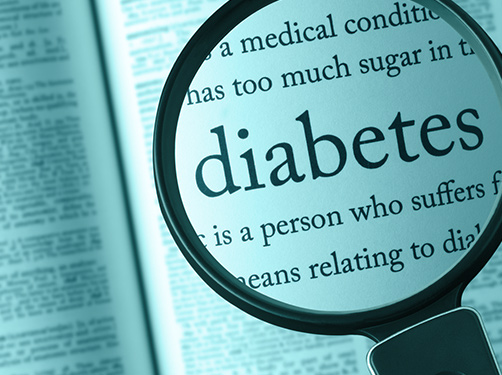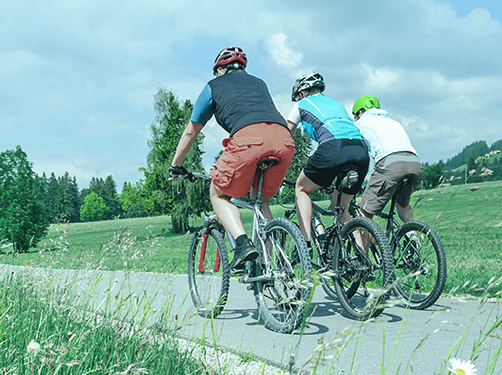Exercise and type 1 diabetes: Keeping sugar levels under control
Scientific support: Dr. Ulrike Becker
One of the biggest everyday challenges with diabetes is keeping blood sugar at optimal levels during and after exercise. However, if you know about the blood sugar-influencing factors and learn to adjust the therapy to the exercise session, you can exercise without problems, even with type 1 diabetes.
Exercise is an important part of life for many people with type 1 diabetes and it offers many health benefits. However, physical activity also has risks. Metabolic imbalances can occur during or after exercise. The risk of hypoglycemia can remain elevated for hours after physical activity and during the night.
This fear stops many people with type 1 diabetes from exercising regularly. However, if you pay attention to certain factors and understand the blood sugar profile, then therapy can be gradually adjusted and optimized.

In general, people with type 1 diabetes can participate in all forms of exercise if they pay attention to their blood sugar profile.Children with type 1 diabetes should take part in physical education class at school as long as the teachers have been informed and keep an eye on the children during class. Even some elite athletes suffer from type 1 diabetes.
Special care must be taken during activities such as diving, skydiving, and extreme climbing. In the event of loss of consciousness – e.g., as a result of Hypoglycemia – these activities have an elevated risk. These types of extreme sports require particularly careful conduct with individualized preparation and detailed instructions in advance.
Contents
- How does exercise benefit people with type 1 diabetes?
- How does a healthy sugar metabolism react to exercise?
- How does exercise influence blood sugar levels in those with type 1 diabetes?
- How can you avoid metabolic imbalances during exercise?
- Therapy adjustment: Are there guidelines?
- How can diabetes technology help with exercise?
1. How does exercise benefit people with type 1 diabetes?
Physical activity reduces the risk of cardiovascular disease and many other diabetes-related secondary diseases. Exercise can also help you achieve a healthy weight and maintain it in the long term.
In cases of preexisting insulin resistance, regular physical activity causes the body’s cells to react more sensitively to the hormone insulin. Subsequently, the long-term blood sugar value (HbA1c value) may also improve.
2. How does a healthy sugar metabolism react to exercise?
During exercise, the body's cells use sugar in the blood to produce energy. This results in a reduction in blood sugar levels during physical activity. The bodies of those with a healthy metabolism, i.e., people without diabetes, react immediately to a drop in blood sugar levels.
- When blood sugar levels are low, the pancreas releases less insulin into the bloodstream. This is because insulin, coupled with the physical activity, would cause blood sugar levels to fall even further.
- The liver also plays a role when sugar levels are too low. For this type of situation, it stores sugar in the form of glycogen, which is released as needed.
To ensure that blood sugar levels remain within a certain range and don’t continue to increase, the body regulates against this:
- The pancreas begins to release insulin again. This causes the cells to utilize sugar from the blood resulting in a fall in blood sugar levels.
These metabolic processes enable the body to keep the blood sugar at optimal levels, even during and after exercise.
In the case of type 1 diabetes, the body does not release its own insulin. Instead, those affected must inject themselves with insulin. Since insulin requirements vary greatly depending on the situation and time of day, it can be challenging for those with type 1 diabetes to maintain insulin levels within the optimal range.
3. How does exercise influence blood sugar levels in those with type 1 diabetes?
When exercising, people with type 1 diabetes must take care to ensure that their blood sugar levels do not fall or increase too much. The most important thing is to avoid low blood sugar levels (hypoglycemia) or high blood sugar levels (hyperglycemia).
If possible blood sugar effects can be assessed, depending on the type of exercise or physical activity, and appropriate action is taken, both metabolic imbalances – low and high blood sugar levels – can generally be well prevented.
The exact way that exercise affects blood sugar depends on various factors. The type, intensity, and duration of the physical activity are the main factors. The time of day during which physical activity takes place and several other aspects also influence blood sugar levels.
Good to know:
Spring cleaning, a short walk, or playing in the schoolyard all require energy and can reduce blood sugar levels.
Type and intensity of physical activity
There is a difference between aerobic and anaerobic physical activity. While aerobic exertion encompasses the repeated and continuous movement of large muscle groups (for example hiking, cycling, running, or swimming), shorter faster training sessions (for example sprints or intense strength training) use anaerobic energy production. Generally, both energy systems are used in different proportions during exercise.
The effects on blood sugar levels differ depending on the type and intensity of the physical activity: Prolonged exercise (endurance sports) – i.e., aerobic activity – lowers blood sugar levels, while short intense exercise – i.e., anaerobic activity – can lead to an increase in blood sugar levels.
The following section explains how metabolic imbalances during and after exercise can be avoided.
Good to know:
The extent and intensity of the physical activity determine how energy is made available. For short intense periods of exertion of up to 2 minutes, anaerobic energy production makes large amounts of energy available within a very short time. During moderately intense periods of exertion of between 1 and 2 hours, the sugar released from glycogen is relevant, however, the storage capacity is limited. With increasing duration, fat burning comes to the fore.
Time of day and insulin requirements
Due to natural fluctuations in hormone levels, insulin requirements are lower around midday and midnight than in the early morning and evening. Therefore, it is recommenced not to reduce insulin intake too much during the daytime physical activities with high insulin requirements to help reduce the risk of high blood sugar levels.
Insulin effects and the type and amount of the previously consumed meal
The amount of insulin effective in the body at the time of exercise must also be considered. Depending on the dosage and injection site, insulin taken during the previous meal can continue to affect the body for several hours. If a person with type 1 diabetes exercises during this period, their blood sugar level can drop significantly.
Also, the type and amount of the previously consumed carbohydrates affect blood sugar levels. Complex carbohydrates (such as in wholewheat bread, vegetables, and fruits) are more slowly absorbed into the blood. The intake of carbohydrates in combination with fat can affect blood sugar levels from several hours after a meal.
Low blood sugar levels after exercise The muscle replenishment effect
Low blood sugar levels can occur several hours after exercise. This is due to improved insulin sensitivity and what is known as the muscle replenishment effect after exercising. The body tries to refill the empty glycogen stores in the muscles. To achieve this, it takes sugar (glucose) from the blood, which can trigger low blood sugar levels for at least 24 hours after exercising. Especially at night, there is a risk of low blood sugar, which is why people with type 1 diabetes should regular test their blood sugar levels following exercise.
For people with type 1 diabetes who have a tendency to low blood sugar levels at night, it is recommended that they exercise in the morning rather than in the evening.
Important: Blood sugar levels can also drop after intense anaerobic forms of exertion. Depending on the intensity, both high or low blood sugar levels can occur in exercise that alternates between aerobic and anaerobic energy production.
Good to know:
Learn from an experienced diabetes team – especially when you have recently been diagnosed with type 1 diabetes or you wish to try out new forms of exercise. Do your research in internet forums to read reports of the experiences of other people with type 1 diabetes.
4. How can you avoid metabolic imbalances during exercise?
- Frequent blood sugar testing
Test your blood sugar levels regularly (before, during, and after exercise) to allow you to act quickly.
Initial blood sugar level
Blood sugar levels should be below 270 mg/dl (15 mmol/l) before beginning physical activity. A blood sugar level of between 126 and 180 mg/dl (7.0 to 10.0 mmol/l) is recommended for aerobic exercise. You should not exercise if your blood sugar levels are above 270 mg/dl (15 mmol/l) with ketones detectable in your blood or urine. There is a risk of diabetic Ketoacidosis.
You should not begin to exercise if your blood sugar is below 90 mg/dl (5.0 mmol/l). You are at risk of a low blood sugar. Eat some carbohydrates and wait a little while. Suitable sources are fruits (e.g., ripe bananas) or liquid carbohydrates (e.g., juice).
Individual blood sugar curves depending on the type of exercise
Please pay attention to the fact that blood sugar levels can react differently depending on the type of exercise. Endurance exercises such as running, cycling, or swimming reduce blood sugar levels. In contrast, intense exertion, such as strength or sprint training, can cause a temporary blood sugar increase. Later on in this text, you can find out how to adjust your training sessions. Because the onset of low blood sugar levels can be delayed, correction should be carried out carefully using insulin. Keep an eye on blood sugar levels after exercising.
- Keep carbohydrates on hand
Always take fast-acting carbohydrates to your exercise sessions. Liquid carbohydrates, such as juices, are especially suitable. This allows you to act immediately in the event of low blood sugar levels. For exercise lasting several hours, e.g., hiking, it makes sense to have slow-acting carbohydrates on hand (for example, muesli bars or sandwiches) to help stabilize blood sugar levels.
- Stress can increase blood sugar levels
Stress, such as competitive sports, and the resulting release of adrenalin, can cause a temporary blood sugar level increase. Care should be taken when using insulin for counter-regulation to avoid low blood sugar levels later on. In these types of situations, test your blood sugar frequently.
- Keep an exercise diary
Each body reacts to exercise in a very individual manner that depends on numerous factors. To document your experiences, it is useful to keep an exercise diary. The recording of blood sugar levels, insulin dose, and carbohydrate intake in an exercise diary helps to identify patterns. This makes it easier to optimize diabetes therapy for exercising.
- Slow-acting carbohydrates after endurance exercise
The onset of low sugar levels can be delayed by several hours after endurance or intense exertion. To avoid low sugar levels during the night, make sure to eat, in the evening if required, additional slow-acting carbohydrates after endurance exercise (wholewheat bread, wholewheat pasta, or pulses).
Find out here what to do in case of an emergency.
- Inform those around you of your diabetes
Tell your friends, trainer, or teachers about your disease and the necessary measures in the event of low blood sugar levels.
Good to know:
For questions relating to exercise and diabetes, the IDAA, the International Diabetic Athletes Association (IDAA in German) (Link in German), offers a wide range of information and contacts and information on interesting events.
5. Therapy adjustment: Are there guidelines?
In general, there are 3 methods to adjust therapy before exercise:
- The intake of additional carbohydrates
- A reduction of the insulin dosage
- A combination of both of these methods
It is difficult to give broadly applicable guideline values on how much insulin intake should be reduced before physical activity. People with type 1 diabetes should definitely discuss their training plan in advance with a diabetes professional. During specialist instruction, you will learn to assess the individual reaction of your metabolism to physical exertion.
What should the blood sugar level be before exercising?
As a rule of thumb: Before exercising, it is essential to test the blood sugar levels.
For aerobic training lasting up to 1 hour (for example, walking, hiking, running, or swimming), initial levels of 126 to 180 mg/dl (7.0 to 10.0 mmol/l) are optimal.
For planned high-intensity training with anaerobic exertion (for example, intense strength or sprint training), the somewhat lower initial blood sugar level of 90 to 124 mg/dl (5.0 to 6.9 mmol/l) is better, as the blood sugar level tends to remain stable and sink less than during aerobic training.
The following table provides an overview on what to do before exercise depending on the initial blood sugar levels:
Initial blood sugar |
|
Below 90 mg/dl | |
+10 to 20 g carbohydrates | |
90 to 124 mg/dl | +10 g carbohydrates before aerobic training |
126 to 180 mg/dl | Start aerobic training |
182 to 270 mg/dl | |
Start aerobic training | |
above 270 mg/dl | If unexpected, conduct ketone blood testing:
|
Modification after Riddell, M. C. et al.: Exercise Management in type 1 diabetes: a consensus statement. In: Lancet Diabetes Endocrinol, 2017, 5: 377-390
Adjustment of the bolus and basal insulin doses
The insulin dose adjustment can take place via a reduction of the basic insulin requirement (basal insulin or basal rate) and a reduction of the bolus insulin dose (mealtime insulin). The correct method for each case depends on many individual factors. Below you can find information that may be helpful for insulin dose adjustment:
- Bolus insulin (mealtime insulin): If you are planning an exercise session 2 to 3 hours after a meal with bolus insulin administration, you should reduce the bolus insulin dose depending on the intensity of the planned exercise session. The following table provides orientation.
- Basal insulin (basic insulin requirement): Before exercise lasting several hours or the whole day, you should administer up to 25 percent less basal insulin (in addition to the mealtime insulin reduction). However, this is very individual and should be tested out depending on the exertion intensity and duration.
- Basal rate (basic insulin requirement associated with pump therapy): If possible, the basal rate should be reduced by between 50 and 80 percent 60 to 90 minutes before the training session. In contrast, if this is done shortly before exercising, the blood sugar level may still fall. The basal rate reduction is dependent on various factors and therefore must be determined on an individual basis. However, generally, if using a short-acting insulin analog, it is recommended to pause the basal rate for a maximum of 2 hours.
If the insulin dose is reduced too much, then high blood sugar levels can occur – especially if the training was intensive.
Reduction of the bolus insulin (mealtime insulin)
Depending on the training duration and intensity (when training takes place 2 to 3 hours after the last meal).
| Training duration 30 mins | Training duration 60 mins |
Light aerobic training (e.g., walking, hiking, leisurely cycling) | ||
25 percent reduction | 50 percent reduction | |
Moderate aerobic training (e.g., walking, fast cycling, swimming) | 50 percent reduction | 75 percent reduction |
Intense aerobic training (e.g., football, volleyball, strength training) | 75 percent reduction | Training sessions of this intensity are usually not maintained for more than 60 minutes at a time. |
Intense aerobic or anaerobic training (e.g., sprints, intense strength training, or interval training) | ||
No reduction | Training sessions of this intensity are usually not maintained for more than 60 minutes at a time. |
Modification after Rhabasa-Lhoret, R. et al.: Guidelines for Premeal Insulin Dose Reduction for Postprandial Exercise of Different Intensities and Durations in Type 1 Diabetic Subjects Treated Intensively With a Basal-Bolus Insulin Regimen (Ultralente-Lispro). In: Diabetes Care, 2001, 24: 625-630
Good to know:
Adjusting therapy to training sessions can only work if coupled with well-controlled diabetes therapy, regular blood sugar level testing, and training under everyday conditions.
Carbohydrate intake recommendations
Alongside the adjustment of the insulin dosage, the intake of carbohydrates is usually indispensable in helping to avoid low sugar levels.
- If the effects of the bolus insulin are evident during a 60-minute training session, then up to 30 grams of carbohydrates should be consumed every 30 minutes.
- For training sessions lasting between 60 and 150 minutes, between 30 and 60 grams of carbohydrates per hour should be consumed. If the effects of the bolus insulin are evident, then up to 90 grams of carbohydrate.
- When training for more than 150 minutes, 30 to 90 grams of additional carbohydrates per hour are recommended.
Avoid low blood sugar after exercise
After an exercise session, the body will attempt to replenish the empty glycogen stores in the muscles. For those with type 1 diabetes, this means an elevated risk of low sugar levels. This should be taken into consideration, especially after intense training sessions late in the afternoon or in the evening because low sugar level can develop during the night. This can be counteracted by a 50 percent bolus insulin reduction for the meal after training. Additionally, a snack with a low glycemic index (GI) can be consumed at night before going to bed. A 20 percent reduction of the basal rate can also reduce the risk of low blood sugar levels during the night. Otherwise, blood sugar testing will also be necessary during the night.
Good to know:
The consumption of alcohol after exercising increases the risk for low blood sugar levels during the night.
6. How can diabetes technology help with exercise?
Insulin pumps, systems for continuous glucose monitoring (CGM), and hybrid closed-loop systems simplify exercise-related therapy adjustment for people with type 1 diabetes.
Using an insulin pump, the basal rate can be reduced during a certain period.
Those using a CGM system can keep track of their sugar levels when exercising. However, during training, there may be a significant delay between the actual body sugar level and the tested tissue sugar value. For this reason, a system with an alarm function is recommended. The lowest alarm threshold should be set as high as possible – for example, 100 mg/dl (5.6 mmol/l). This allows the person to have their attention drawn to their low blood sugar in a timely manner, even when the tissue sugar value is (still) higher than the blood sugar level.
There are now systems that transmit the current sugar levels to other users via smartphone. For example, parents can keep track of their children’s blood sugar level while they play sports.
There are also closed-loop systems that automatically adjust the insulin therapy in line with the exercise. If possible, ideally, the duration and intensity of the exercise session should be entered into the device one hour in advance. The algorithm will then aromatically reduce the basal rate and also the bolus insulin dose during mealtimes. Hybrid closed-loop systems can significantly help diabetes management associated with physical activity.
Sources:
Becker, U. et al.: Sport mit Typ 1 Diabetes. In: Diabetologe, 2021, 17: 121-130
Bohn, B. et al.: Impact of Physical Activity on Glycemic Control and Prevalence of Cardiovascular Risk Factors in Adults With Type 1 Diabetes: A Cross-sectional Multicenter Study of 18,028 Patients. In: Diabetes Care, 2015, 38: 1536-1543
Eckstein, M. L. et al.: Time in Range for Closed-Loop Systems versus Standard of Care during Physical Exercise in People with Type 1 Diabetes: A Systematic Review and Meta-Analysis. In: J Clin Med, 2021, 10: 2445
Esefeld, K. et al.: Diabetes, Sport und Bewegung. In: Diabetologe, 2020, 16: 292-299
Internationale Vereinigung diabetischer Sportler: Anpassung der Diabetes-Therapie an körperliche Belastung und Sport. (Letzter Abruf: 09.11.2022)
Moser, O. et al.: Glucose management for exercise using continuous glucose monitoring (CGM) and intermittently scanned CGM (isCGM) systems in type 1 diabetes – Position Statement of the European Association for the Study of Diabetes (EASD) and of the International Society for Pediatric and Adolescent Diabetes (ISAD) endorsed by JDRF and supported by the American Diabetes Association (ADA). In: Diabetologia, 2020, 63: 2501-2520
Rhabasa-Lhoret, R. et al.: Guidelines for Premeal Insulin Dose Reduction for Postprandial Exercise of Different Intensities and Durations in Type 1 Diabetic Subjects Treated Intensively With a Basal-Bolus Insulin Regimen (Ultralente-Lispro). In: Diabetes Care, 2001, 24: 625-630
Riddell, M. C. et al.: Exercise Management in type 1 diabetes: a consensus statement. In: Lancet Diabetes Endocrinol, 2017, 5: 377-390
Tikkanen-Dolenc, H. et al.: Frequent and intensive physical activity reduces risk of cardiovascular events in type 1 diabetes. In: Diabetologia, 2017, 60: 574-580
As of: 09.11.2022






